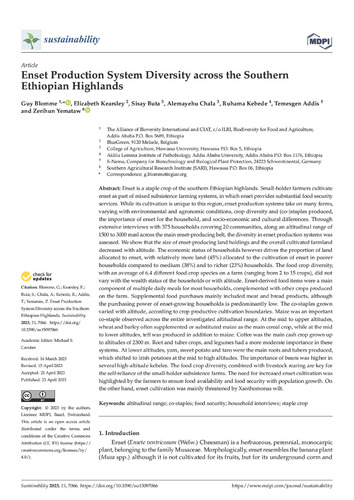Enset production system diversity across the Southern Ethiopian Highlands
Enset is a staple crop of the southern Ethiopian highlands. Small-holder farmers cultivate enset as part of mixed subsistence farming systems, in which enset provides substantial food security services. While its cultivation is unique to this region, enset production systems take on many forms, varying with environmental and agronomic conditions, crop diversity and (co-)staples produced, the importance of enset for the household, and socio-economic and cultural differences. Through extensive interviews with 375 households covering 20 communities, along an altitudinal range of 1500 to 3000 masl across the main enset-producing belt, the diversity in enset production systems was assessed. We show that the size of enset-producing land holdings and the overall cultivated farmland decreased with altitude. The economic status of households however drives the proportion of land allocated to enset, with relatively more land (45%) allocated to the cultivation of enset in poorer households compared to medium (38%) and to richer (23%) households. The food crop diversity, with an average of 6.4 different food crop species on a farm (ranging from 2 to 15 crops), did not vary with the wealth status of the households or with altitude. Enset-derived food items were a main component of multiple daily meals for most households, complemented with other crops produced on the farm. Supplemental food purchases mainly included meat and bread products, although the purchasing power of enset-growing households is predominantly low. The co-staples grown varied with altitude, according to crop productive cultivation boundaries. Maize was an important co-staple observed across the entire investigated altitudinal range. At the mid to upper altitudes, wheat and barley often supplemented or substituted maize as the main cereal crop, while at the mid to lower altitudes, teff was produced in addition to maize. Coffee was the main cash crop grown up to altitudes of 2300 m. Root and tuber crops, and legumes had a more moderate importance in these systems. At lower altitudes, yam, sweet potato and taro were the main roots and tubers produced, which shifted to Irish potatoes at the mid to high altitudes. The importance of beans was higher in several high-altitude kebeles. The food crop diversity, combined with livestock rearing are key for the self-reliance of the small-holder subsistence farms. The need for increased enset cultivation was highlighted by the farmers to ensure food availability and food security with population growth. On the other hand, enset cultivation was mainly threatened by Xanthomonas wilt.

